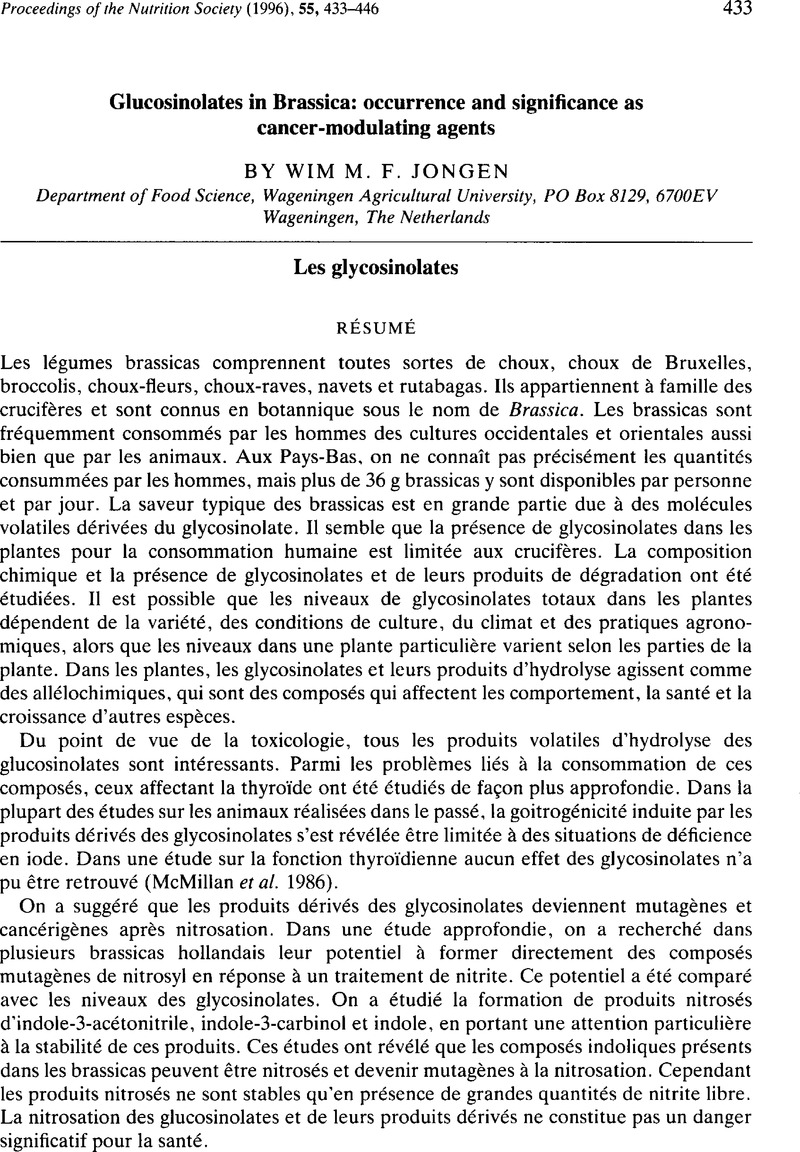Crossref Citations
This article has been cited by the following publications. This list is generated based on data provided by Crossref.
Zhao, F. J.
Withers, P. J. A.
Evans, E. J.
Monaghan, J.
Salmon, S. E.
Shewry, P. R.
and
McGrath, S. P.
1997.
Plant Nutrition for Sustainable Food Production and Environment.
p.
917.
Zhao, F. J.
Withers, P. J. A.
Evans, E. J.
Monaghan, J.
Salmon, S. E.
Shewry, P. R.
and
McGrath, S. P.
1997.
Sulphur nutrition: An important factor for the quality of wheat and rapeseed.
Soil Science and Plant Nutrition,
Vol. 43,
Issue. sup1,
p.
1137.
Rijnkels, Jolanda M
Delsing, (Dianne) B.J.M
van der Reijden, Astrid C
and
Alink, Gerrit M
1998.
Effects of vegetables–fruit extracts and indole-3-carbinol on stearic acid-modulated intercellular communication and cytochrome P450-IA activity.
Environmental Toxicology and Pharmacology,
Vol. 6,
Issue. 2,
p.
103.
Barrett, Joyce E
Klopfenstein, Carol F
and
Leipold, Horst W
1998.
Protective effects of cruciferous seed meals and hulls against colon cancer in mice.
Cancer Letters,
Vol. 127,
Issue. 1-2,
p.
83.
Verkerk, Ruud
Dekker, Matthijs
and
Jongen, Wim M.F.
1999.
Agri-Food Quality II.
p.
366.
Fraser, Gary E
1999.
Associations between diet and cancer, ischemic heart disease, and all-cause mortality in non-Hispanic white California Seventh-day Adventists.
The American Journal of Clinical Nutrition,
Vol. 70,
Issue. 3,
p.
532S.
Michaud, D. S.
Spiegelman, D.
Clinton, S. K.
Rimm, E. B.
Willett, W. C.
and
Giovannucci, E. L.
1999.
Fruit and Vegetable Intake and Incidence of Bladder Cancer in a Male Prospective Cohort.
JNCI Journal of the National Cancer Institute,
Vol. 91,
Issue. 7,
p.
605.
Mithen, Richard F
Dekker, Matthijs
Verkerk, Ruud
Rabot, Sylvie
and
Johnson, Ian T
2000.
The nutritional significance, biosynthesis and bioavailability of glucosinolates in human foods.
Journal of the Science of Food and Agriculture,
Vol. 80,
Issue. 7,
p.
967.
Graser, Gerson
Schneider, Bernd
Oldham, Neil J
and
Gershenzon, Jonathan
2000.
The Methionine Chain Elongation Pathway in the Biosynthesis of Glucosinolates in Eruca sativa (Brassicaceae).
Archives of Biochemistry and Biophysics,
Vol. 378,
Issue. 2,
p.
411.
Gross, Heidrun B
Dalebout, Tim
Grubb, C.Douglas
and
Abel, Steffen
2000.
Functional detection of chemopreventive glucosinolates in Arabidopsis thaliana.
Plant Science,
Vol. 159,
Issue. 2,
p.
265.
Elfoul, Lila
Rabot, Sylvie
Khelifa, Nasser
Quinsac, Alain
Duguay, Annabelle
and
Rimbault, Alain
2001.
Formation of allyl isothiocyanate from sinigrin in the digestive tract of rats monoassociated with a human colonic strain of Bacteroides thetaiotaomicron.
FEMS Microbiology Letters,
Vol. 197,
Issue. 1,
p.
99.
Schöne, Friedrich
Leiterer, Matthias
Hartung, Horst
Jahreis, Gerhard
and
Tischendorf, Frank
2001.
Rapeseed glucosinolates and iodine in sows affect the milk iodine concentration and the iodine status of piglets.
British Journal of Nutrition,
Vol. 85,
Issue. 6,
p.
659.
Zhu, C.-Y
and
Loft, S
2001.
Effects of Brussels sprouts extracts on hydrogen peroxide-induced DNA strand breaks in human lymphocytes.
Food and Chemical Toxicology,
Vol. 39,
Issue. 12,
p.
1191.
Krul, Cyrille
Humblot, Christèle
Philippe, Catherine
Vermeulen, Martijn
van Nuenen, Marleen
Havenaar, Robert
and
Rabot, Sylvie
2002.
Metabolism of sinigrin (2-propenyl glucosinolate) by the human colonic microflora in a dynamic in vitro large-intestinal model.
Carcinogenesis,
Vol. 23,
Issue. 6,
p.
1009.
Steer, Toni E.
and
Gibson, Glenn R.
2002.
The microbiology of phytic acid metabolism by gut bacteria and relevance for bowel cancer.
International Journal of Food Science & Technology,
Vol. 37,
Issue. 7,
p.
783.
Zhu, C.-Y
and
Loft, S
2003.
Effect of chemopreventive compounds from Brassica vegetables on NAD(P)H:quinone reductase and induction of DNA strand breaks in murine hepa1c1c7 cells.
Food and Chemical Toxicology,
Vol. 41,
Issue. 4,
p.
455.
Edenharder, R.
Krieg, H.
Köttgen, V.
and
Platt, K.L.
2003.
Inhibition of clastogenicity of benzo[a]pyrene and of its trans-7,8-dihydrodiol in mice in vivo by fruits, vegetables, and flavonoids.
Mutation Research/Genetic Toxicology and Environmental Mutagenesis,
Vol. 537,
Issue. 2,
p.
169.
McNaughton, S. A.
and
Marks, G. C.
2003.
Development of a food composition database for the estimation of dietary intakes of glucosinolates, the biologically active constituents of cruciferous vegetables.
British Journal of Nutrition,
Vol. 90,
Issue. 3,
p.
687.
Sakauchi, Fumio
Mori, Mitsuru
Washio, Masakazu
Watanabe, Yoshiyuki
Ozasa, Kotaro
Hayashi, Kyohei
Miki, Tsuneharu
Nakao, Masahiro
Mikami, Kazuya
Ito, Yoshinori
Wakai, Kenji
and
Tamakoshi, Akiko
2004.
Dietary Habits and Risk of Urothelial Cancer Death in a Large-Scale Cohort Study (JACC Study) in Japan.
Nutrition and Cancer,
Vol. 50,
Issue. 1,
p.
33.
Sakauchi, Fumio
Mori, Mitsuru
Washio, Masakazu
Watanabe, Yoshiyuki
Ozasa, Kotaro
Hayashi, Kyohei
Miki, Tsuneharu
Nakao, Masahiro
Mikami, Kazuya
Ito, Yoshinori
Wakai, Kenji
and
Tamakoshi, Akiko
2005.
Dietary Habits and Risk of Urothelial Cancer Incidence in the JACC Study.
Journal of Epidemiology,
Vol. 15,
Issue. Supplement_II,
p.
S190.





